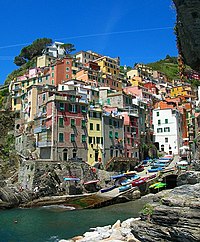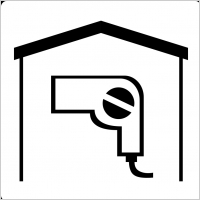Wikipedia entry
Riomaggiore (Rimazùu [rimazu ː] in the local dialect of Ligurian language, Rimazò in other variants) is an Italian town of 1.693 inhabitants of the province of La Spezia in Liguria. Ancient village of the Riviera di Levante, is the easternmost and southernmost of the so-called Cinque Terre.
Physical Geography

Riomaggiore, Cinque Terre as well as other, is sandwiched between ilmar Ligure and the steep mountain range that separates the Apennines near Mount Zatta and descends to the south-east by the watershed between the Val di Vara and the coastal area. The center, whose original building dates back alXIII century, is located in the valley of the river Rio Maggiore, Antico Rivus Major from which the village takes its name.
The village is composed of several parallel rows of houses torrigenovesi following the steep course of the stream. The new district station, so named as it has developed since the second half of the nineteenth century, following the arrival of the railroad, Instead it is located in the adjacent valley of the river Rio Finale (Rufinàu), so named because it once marked the boundary between the lands of those Riomaggiore and Manarola (Manaèa).
The two valleys on which lies the town are separated from the steep costs of Champion (Canpiòn), on the lower part of which stands the castle of the village. The valley of the Rio Maggiore is topped by Mount Verugola (Verügua), whose three peaks, depicted in the coat of arms, have always been the symbol of the village.
In addition to capital, are part of the common of the three fractions of Manarola, Volastra and Groppo, and other nuclei now uninhabited hills, for a total of 10,3 square kilometers.
The territory is part of the National Park of Cinque Terre.
It is bordered to the north by the municipality of Riccò del Golfo di Spezia, to the south is wet from the Ligurian Sea, to the west and to the east by Vernazza La Spezia. Is about 15 kilometers to the west and dellaSpezia 117 kilometers east of Genoa.
Climate
Riomaggiore, protected from the Apennines of Liguria, is both bathed from the Ligurian Sea. So it enjoys a mild climate. Summer temperatures are not excessively high, and the winter are not rigid. The municipality belongs to the climatic zone D.
Story

The origin of the village of Riomaggiore, according to an ancient legend passed down orally but not confirmed by historical sources, is traced back to the eighth century. It is said that a group of Greek refugees, to escape persecution iconoclast emperor Leo III of Byzantium, After various adventures they landed at the tip of Montenero and formed settlements in the area of the ridge. These villages, which included Cacinagora, Serum, Montenero, Limen and Casale, were then attached to the brand obertenga.
It was only after the year 1000 that, due to the greater safety of the seas due to the expansion of the Republic of Genoa, the primitive inhabitants of the settlements could gradually go down hill towards the sea, giving birth to the first core of the village of Riomaggiore, still located in the Marina District.
The first historical territory date back to Riomaggiore 1251, when the inhabitants of the district of Carpena gathered to swear allegiance to the Republic of Genoa in the war against Pisa.
The villages were, however, then still the feud Marquis Turcotti, Lord of Ripalta, near Borghetto Vara, which around 1260 built the local castle and other fortifications.
The territory of Riomaggiore then passed to the Fieschi, from which it was sold in 1276 in Genoa, together with the other villages of the Cinque Terre and most of eastern Liguria.
The Genovese assured the Cinque Terre a period of political calm and economic expansion and commercial: in this period was strengthened viticolturaattraverso the work of terracing of the hills and the wine produced there became famous throughout Europe. In the Cinque Terre This growth was expressed in the construction of new churches, larger and more beautiful than the original. In Riomaggiore dellaparrocchiale the construction of St. John the Baptist began in 1340 by the bishop of LuniAntonio Fieschi.
The history of Riomaggiore then followed the changing fortunes of the republic of Genoa, who included the territory of the Podesta Vernazza, until its decline.
With the new French rule from the fall of Napoleon Bonaparte 2 December 1797nel Department of the Gulf of Venus, with capital La Spezia, within dellaRepubblica Ligure annexed to the First French Empire. From 28 aprile del 1798 with the new French law, Riomaggiore will fall in the eighth canton, capital Vernazza, Jurisdiction of the Gulf of Venus. From 1803 was the main center of the third State of the Gulf of Venus in the Jurisdiction of the Gulf of Venus. From 13 June 1805 to the 1814 will be included in the Department of the Apennines.
In 1815 will be incorporated into the Kingdom of Sardinia, as established by the Congress of Viennadel 1814 for other municipalities in the Ligurian Republic, and later in the Kingdom of Italy from 1861. From 1859 to the 1927 the territory was included in the First district of Speziadel Environment Levante part of the Province of Genoa and, with the establishment in 1923, of the Province of La Spezia.
At the end of the nineteenth century, thanks to the construction of the railway line Genova-La Spezia, Riomaggiore, Cinque Terre emerged from a historical isolation, even if the roadway will come only in the sixties of the next century.
From 1973 to the 31 December 2008 he was a member of the Montana coast of La Spezia, suppressed by the Regional Law n ° 24 of 4 July 2008 and in force since 1 January 2009.
Symbols

| « Three mountains rising from the sea side with leafy branches and crown above » | |
|
(Description of the heraldic coat of arms[9])
|
The emblem depicts the three peaks of Mount Verugola, symbol of the country.
Monuments and places of interest
Religious Architecture
- Parish Church of St. John the Baptist in the upper part of the historic center of Riomaggiore, of 1340.
- Church of St. Anthony in the historic center of Riomaggiore. According to tradition is the oldest religious building in the village, since it was built in the thirteenth century and presumably assumed the role of the first parish in the country. The fresco portraying the titular saint of the church dates back to the eighteenth century.
- Oratory of the Assumption in the historic center of Riomaggiore. Dating back to the sixteenth century and best known as the church of the Society (Cunpagnia), as the headquarters of the Brotherhood of Our Lady Assumed into Heaven.
- Oratory of St. Rocco and St. Sebastian, near the castle of Riomaggiore, del1480.
- Shrine of Our Lady of Montenero (Munteneigru), located on the hill overlooking the village.
- Chapel of San Bernardo, located in a small uninhabited village of Lemmen (Limen), nuclei of an ancient hill from which the country had its origin.
- Church of San Lorenzo in the village of Manarola, of 1338.
- Oratory of the Confraternity of the Santissima Annunziata Disciplinanti, or Blue, in the village of Manarola; The building dates back to the fifteenth century.
- Shrine of Our Lady of Health in the village of Volastra, of the XII century in Romanesque style.
Military architecture
- Castle of Riomaggiore, in the upper part of the historic center riomaggiorese, built by the Marquis Turcotti in 1260 and brought to an end by the Genoese in the fifteenth and sixteenth centuries.
- Bastion of Manarola, from the eponymous village, dating back to an earlier period alXIII century.
Languages and dialects
In addition to the Italian language, Riomaggiore is spoken by the population of the local dialect, a variant of Ligurian language. The dialect has riomaggiorese own special way, also be clearly distinguished from the dialects spoken in the neighboring towns.
Culture
Kitchen
Being a village of Riomaggiore essentially peasant culture and maritime, The dish par excellence is not, As one might expect, a dish of sea, but ground. This is the salted rice cake (aa turta de risu), prepared according to tradition, on the occasion of the patronal feast of St. John the Baptist (San Gian).
Another main dish, preparation, especially in winter, is the soup of the field (aa stew of cyan), seasoned with olive oil and made, as well as with potatoes, with the wild herbs that grow spontaneously in terraces planted with vines, among whichscrépuu (radicchio field), sexìrbua (sow-thistle), ravèste (ravastrello), gide (chard),purasèu (garlic vines), bavaàta (red valerian) and cudegàn.
Other typical dishes include ravioli (ravièi), prepared during the holidays and in particular consumed according to the tradition for three consecutive days during the carnival, the top of the Genoese, pesto and the cake made with chestnut flour, call Patona (patùna) or chestnut(castagnàsu). Among the most popular seafood in the traditional cuisine riomaggiorese are stockfish (stuchefisu), le acciughe salate (anciüe) and the stuffed mussels (cin musculi).
Figures involved in Riomaggiore
- Anthony Palermo (1832-1905), lawyer and Garibaldi, native of the village.
- Signorini (1835-1901), Tuscan painter and engraver, attended Riomaggiore and the other towns of the Cinque Terre.
- Silvio Benedetto (1938), painter, Argentine sculptor and muralist, realize many of his murals in the territories of the Cinque Terre.
Events

Among the most important events organized in Riomaggiore we must remember the Grape Festival, duel between the various districts of the town, held on the occasion of the harvest. For several years, this event is not, however, more organized: the last edition was that of 1991.
Media
Riomaggiore is the first Italian town to be equipped with a cable television system connected to a single satellite dish receiver of property of the City, which has banned the use of normal antennas on the roof to protect the aesthetics of the landscape. The system allows you to receive, addition to the main Italian and foreign issuers, a series of local networks, between which the channel of the municipal administration (TeleRio) and that of the National Park of Cinque Terre(TeleParco5Terre), and some channels that broadcast images of fixed cameras that pick up the scenery and backdrops. Even the satellite network Sky, Thanks to a special convention, is transmitted to users through the municipal plant.
Economy
The economy riomaggiorese, once based almost exclusively on agriculture, especially the cultivation of the vine, today is based primarily on tourism: Cinque Terre, thanks to the beauty of the terraced landscape, Indeed welcome visitors from around the world. We can therefore say, from this point of view, that the fortune of riomaggioresi today is based on the work of those of yesterday, which the generations have changed and made arable the steep hillsides.
From the second half of the twentieth century, However, there has been a slow decline of the terraced landscape, due to the progressive abandonment of the cultivation of life by residents, attracted to occupations less tiring and more rewarding.
Infrastructure and transport
Roads
The Motorway, you need to exit at S. Stefano Magra-La Spezia or the A12 sull'A15. Crossing the city of La Spezia, you must take on the provincial 32 (State already 370), better known as “Coast of the Cinque Terre”, After about fifteen minutes, past two galleries, take right on the ramp leading down to Riomaggiore.
However, note that most parking spaces are reserved for residents, for which reason, when those payments are exhausted, the descent to the village may be temporarily prohibited. However, there is a bus service operated by the electrical National Park of the Cinque Terre during periods of increased tourist inflow provides a shuttle connection between the town and the Resort.
Railways
The Riomaggiore train station is located on the Tyrrhenian line Pisa – Genoa. Will stop almost all regional trains, including those in medium-haul once classified as direct or inter. For long-distance trains, essentially Intercity, the most convenient changing station, Coming from the north and south, Central to La Spezia is. Only in some cases, Coming from the north, you can change in Monterosso Station.
Shipping lines
The village is also accessible by sea, either by private transport, with both the ferry line in the Cinque Terre. In the tourist season a scheduled boat service connects Riomaggiore to Monterosso al Mare and Porto Venere, the latter in turn is connected thelatest Spezia and Lerici.
Trails
Riomaggiore is accessible on foot via two main paths, both reported by the section of La Spezia in the Italian Alpine Club. The first number is the ridge trail 1, known as the Cinque Terre Haute via. This ancient trail runs along the watershed that separates the coast from the Val di Vara and is a sub-branch of the Alta Via of the Ligurian Mountains, to which it connects at the Monte Zatta.
The quickest way to reach the village from the ridge trail is along the transverse path 01 which departs from the Cross and pass down along the coast of Champion (Canpiòn), the secondary ridge which separates the valley of the Rio Maggiore from the Rio Final. In alternative, you can take the path 3, which comes off at the resort Telegraph and first reaches the sanctuary of Monterosso, and then the fishing village through the valley of the Rio Maggiore and its tributary Ria.
A third solution is then represented by path 02 which starts near Mount Galera and get off in the direction of Manarola, turning onto the trail that follows the coast unnumbered Corniolo (Curnièu), the secondary ridge which separates the valley of the Rio Final Groppo from the river, where stands the village of Manarola.
The second path is the main coastal route number 2, part of a larger itinerary that crosses the entire Riviera and is known as blue path, which runs through all the Cinque Terre from Monterosso to Riomaggiore, assuming the latter in the stretch between Manarola and the appearance of the famous Way of Love. Unlike that of the ridge, the coastal path is, however, subject to the payment of a toll introduced by the National Park of the Cinque Terre as a contribution to the preservation of the terraced landscape.
Sport
The local football club is the Sports Club Rio Maior, that plays in the championship DiPrima Category. The home field is the “Peter Viola”, better known as Campertone (Canpertón), country by the name of the place where it stands.
Riomaggiore was the arrival stage of the Tour of Italy





















Latest Comments